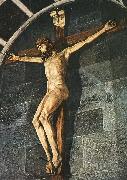
Oil On
Canvas, Real Flavor of Old Masters
|
BELLINI, Giovanni
|
|||
|
|
|||
| Italian High Renaissance Painter, ca.1430-1516 Giovanni Bellini (c. 1430 ?C 1516) was an Italian Renaissance painter, probably the best known of the Bellini family of Venetian painters. His father was Jacopo Bellini, his brother was Gentile Bellini, and his brother-in-law was Andrea Mantegna. He is considered to have revolutionized Venetian painting, moving it towards a more sensuous and colouristic style. Through the use of clear, slow-drying oil paints, Giovanni created deep, rich tints and detailed shadings. His sumptuous coloring and fluent, atmospheric landscapes had a great effect on the Venetian painting school, especially on his pupils Giorgione and Titian. | |||
|
|
|||
|
|
Crucifix BELLINI, Giovanni3.jpg Painting ID:: 5026 Visit European Gallery |
c. 1455 Tempera on wood, 54,5 x 30 cm Museo Correr, Venice | |
Height Width |
INS/CM |
||
|
X |
|
||
|
|
|||
|
BRUNELLESCHI, Filippo
|
|||
|
|
|||
| Italian Early Renaissance Sculptor and Architect, 1377-1446 Filippo Brunelleschi (1377 ?C April 15, 1446) was one of the foremost architects and engineers of the Italian Renaissance. All of his principal works are in Florence, Italy. As explained by Antonio Manetti, who knew Brunelleschi and who wrote his biography, Brunelleschi "was granted such honors as to be buried in Santa Maria del Fiore, and with a marble bust, which they say was carved from life, and placed there in perpetual memory with such a splendid epitaph." In 1401,Brunelleschi entered a competition to design a new set of bronze doors for the baptistery in Florence. Along with another young goldsmith, Lorenzo Ghiberti, he produced a gilded bronze panel, depicting the Sacrifice of Isaac. His entry made reference to a classical statue, known as the 'thorn puller', whilst Ghiberti used a naked torso for his figure of Isaac. In 1403, Ghiberti was announced the victor, largely because of his superior technical skill: his panel showed a more sophisticated knowledge of bronze-casting; it was completed in one single piece. Brunelleschi's piece, by contrast, was comprised of numerous pieces bolted to the back plate. Ghiberti went on to complete a second set of bronze doors for the baptistery, whose beauty Michelangelo extolled a hundred years later, saying "surely these must be the "Gates of Paradise." | |||
|
|
|||
|
|
Crucifix new4/BRUNELLESCHI, Filippo-235663.jpg Painting ID:: 32260 Visit European Gallery |
1412-13 Wood | |
Height Width |
INS/CM |
||
|
X |
|
||
|
|
|||
|
unknow artist
|
|||
|
|
|||
|
|
|||
|
|
Crucifix new16/unknow artist-795763.jpg Painting ID:: 42819 Visit European Gallery |
mk170 1275-1280 Egg temper on poplar 92.1x71cm | |
Height Width |
INS/CM |
||
|
X |
|
||
|
|
|||
|
Cimabue
|
|||
|
|
|||
| Italian b1240 - d1302 Cimabue Location Italian painter and mosaicist. His nickname means either bull-head or possibly one who crushes the views of others (It. cimare: top, shear, blunt), an interpretation matching the tradition in commentaries on Dante that he was not merely proud of his work but contemptuous of criticism. Filippo Villani and Vasari assigned him the name Giovanni, but this has no historical foundation. He may be considered the most dramatic of those artists influenced by contemporary Byzantine painting through which antique qualities were introduced into Italian work in the late 13th century. His interest in Classical Roman drapery techniques and in the spatial and dramatic achievements of such contemporary sculptors as Nicola Pisano, however, distinguishes him from other leading members of this movement. As a result of his influence on such younger artists as Duccio and Giotto, the forceful qualities of his work and its openness to a wide range of sources, Cimabue appears to have had a direct personal influence on the subsequent course of Florentine, Tuscan and possibly Roman painting. | |||
|
|
|||
|
|
Crucifix new20/Cimabue-663252.jpg Painting ID:: 55906 Visit European Gallery |
mk247 1287-88,oil on panel,176x153.5 in ,448x390cm,basilica di santa croce,florence,ltaly | |
Height Width |
INS/CM |
||
|
X |
|
||
|
|
|||










